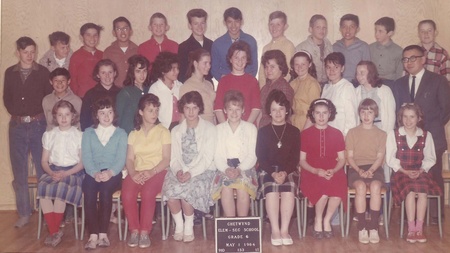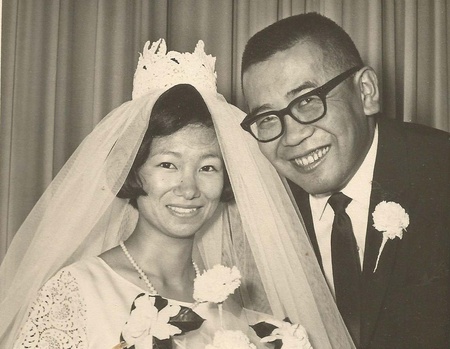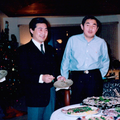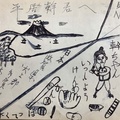Basil stayed with his grandmother and aunts in Vernon from 1949 till they moved to Vancouver in 1954. He says, “At first, during the internment, they had been at Mento Mine outside of Lilloet, BC, at one of the self-supporting sites.1 My other aunt had stayed in east Lilloet along with my grandmother and grandfather. My grandfather had passed way from old age in Lilloet in 1944. When the war ended, both my aunts’ families and my grandmother moved to Vernon, BC. There were quite a few Japanese Canadian families there before the war working as farmers and orchardists and growing fruits of all sorts.” While living in Vernon, Basil, his aunts and grandmother used to attend All Saints Anglican Church and walked about an hour and a half to get there.
During his time in Vernon, Basil learned that his father’s old friend, James Shingo Murakami, who, like Basil’s aunts and grandparents also spent the war years in Lilloet, had recently moved to Vernon where he had set up a new photography business. Basil occasionally went to the shop and visited with Murakami, who gave him news about how his father was doing in Japan.
Basil recalls that there were also some Japanese Canadians living outside Kelowna, a larger town not far from Vernon. There, in contrast to Vernon, anti-Japanese sentiment was much stronger. One of them later told Basil that he didn’t go into town unless necessary due to the severe racism which was even worse than in Vancouver.2
When Basil’s aunt and grandmother moved to Vancouver in 1954, he moved with them, but soon found well-paying work in the forestry industry in the town of Devine and dropped out of high school. He explains, “The sawmill there was worked by a lot of Japanese who had come from the camps around Lilloet3 as well as some who came to Canada after the war. Later they built a planer mill in Devine. In 1954 I went up there and started working. I was seventeen years old, it was my first major job, and I stuck it out for five years.”
In 1959, Basil stopped working in the mill and left Devine for Vancouver in order to finish high school in a school that specialized in adults who had interrupted their education. He completed the remaining two years of high school in one year, then went to North Vancouver High School to take his senior matriculation (grade 13). Then he enrolled in the teacher’s college in UBC. He earned his teacher certificate after two years, then took a third year and got his EA certificate (elementary advanced). He got his first teaching job in Chetland in the Dawson Creek school district (Peace River area), where he taught elementary school for two years, after which he again returned to Vancouver.

Basil got married in August of 1967, the same year he returned to Vancouver. His wife Etsuko (maiden name is Kokubo) is also Japanese Canadian and has roots in Shiga Prefecture, near Hikone City. Coincidently, her family and Basil’s family had both been on the same ship (General Meigs) going to Japan, but did not know each other at that time. She was still a baby when her family had gone to Japan, and had stayed in Japan longer than Basil, eventually returning to Canada with her whole family in 1952.
Basil first met Etsuko at church one summer while boarding in East Vancouver and taking a summer course. He had gotten together with his father’s old friend Shingo Murakami, who invited him to a church service and then to his garden party which was usually held after the church services. Shingo mentioned to Basil that he was going to introduce him to a lady who would also be at the party. When Basil arrived, he noticed a young lady arranging flowers, immediately felt attracted to her, and they were soon dating, so no introduction was needed.
Basil has a very vivid memory of surviving a scary car accident shortly after their engagement. At the time he was teaching in Creston, a town in eastern BC. He had made arrangements to meet up with Etsuko in Penticton, which was a good midway meeting point located in central BC. Unfortunately, while driving to Penticton to meet her, he lost control of the car and it plunged about 100 meters into a ravine, rolling over several times. Basil was not wearing a seatbelt but somehow was able to hold onto the steering wheel and stay inside the car until it stopped rolling. Amazingly, he had only “cuts and bruises” and, while waiting in the hospital to be treated he was able to phone Etsuko’s family in Vancouver to inform her of the situation and cancel the rendezvous. He notes that his survival of this accident caused him to “believe strongly in the existence of guardian angels.”

After they got married, Basil and his wife stayed in Vancouver, and he went to work at Eburne Sawmill at the foot of Marine Drive. This sawmill paid much better than the BC interior sawmills. Meanwhile he was phoning around various school districts in BC looking for teaching work. One of the school districts he had applied to (Ashcroft district in south Caribou) called him, and they moved to nearby Cache Creek. From the very start, Basil found himself working as a relief teacher for the principal of Ashcroft Elementary School in the mornings and also as a relief teacher for the principal of the Cache Creek Elementary School in the afternoons. Soon there was a full time opening in Ashcroft, then an opening in Spences Bridge, where they stayed until their two children started school. He resigned from that position and moved back to Vancouver due to concern about the education of their two children, a girl and a boy. As he puts it, “We didn’t want our kids to start school in a two-room rural school.” Unfortunately, he found that once they were back in Vancouver it was hard to get back into a fulltime teaching career again, so he worked as a substitute teacher for several years.
Basil enjoyed playing sports such as baseball and soccer with his students. His own background as a minority and his past hardships contributed positively to his teaching career. As many of his students were indigenous peoples, he was able to use his difficult experiences as a Japanese Canadian to encourage these students to rise above their circumstances by working harder and not giving in to discouragement.
One day he learned a fish cannery company (Canada Packers at Steveston) was looking for someone who could speak Japanese to work in the salmon roe operation. Japan was their main export market. Basil successfully applied for this position and continued for a long time until Canada Packers closed, at which time he transferred to a cannery operated by Canadian Fish at the foot of Main Street in Vancouver. He continued there for about 20 years. He retired when he was 67, two years later than normal retirement age as the company requested him to stay on.
To be continued...
Notes:
1. While the vast majority of Japanese Canadians were forcibly uprooted from the coast and moved to internment camps, a smaller number with sufficient financial means were allowed to move themselves to less restrictive locations which were hence called “self-supporting sites”. Here they were allowed to engage in agricultural and forestry-related work.
2. See Tatchel, 29-34. This was also said to the writer by Ross Tamagi, a member of Holy Cross Church who grew up near Kelowna.
3. These had also been “self-supporting sites” during the internment period.
* This series is an abridged version of the original article titled, “A Japanese Canadian Child-Exile: The Life History of Basil Izumi,” originally published in The Journal of the Institute for Language and Culture, Konan University, Vol. 22, pp.71-108 (March 2018).
© 2018 Stanley Kirk








